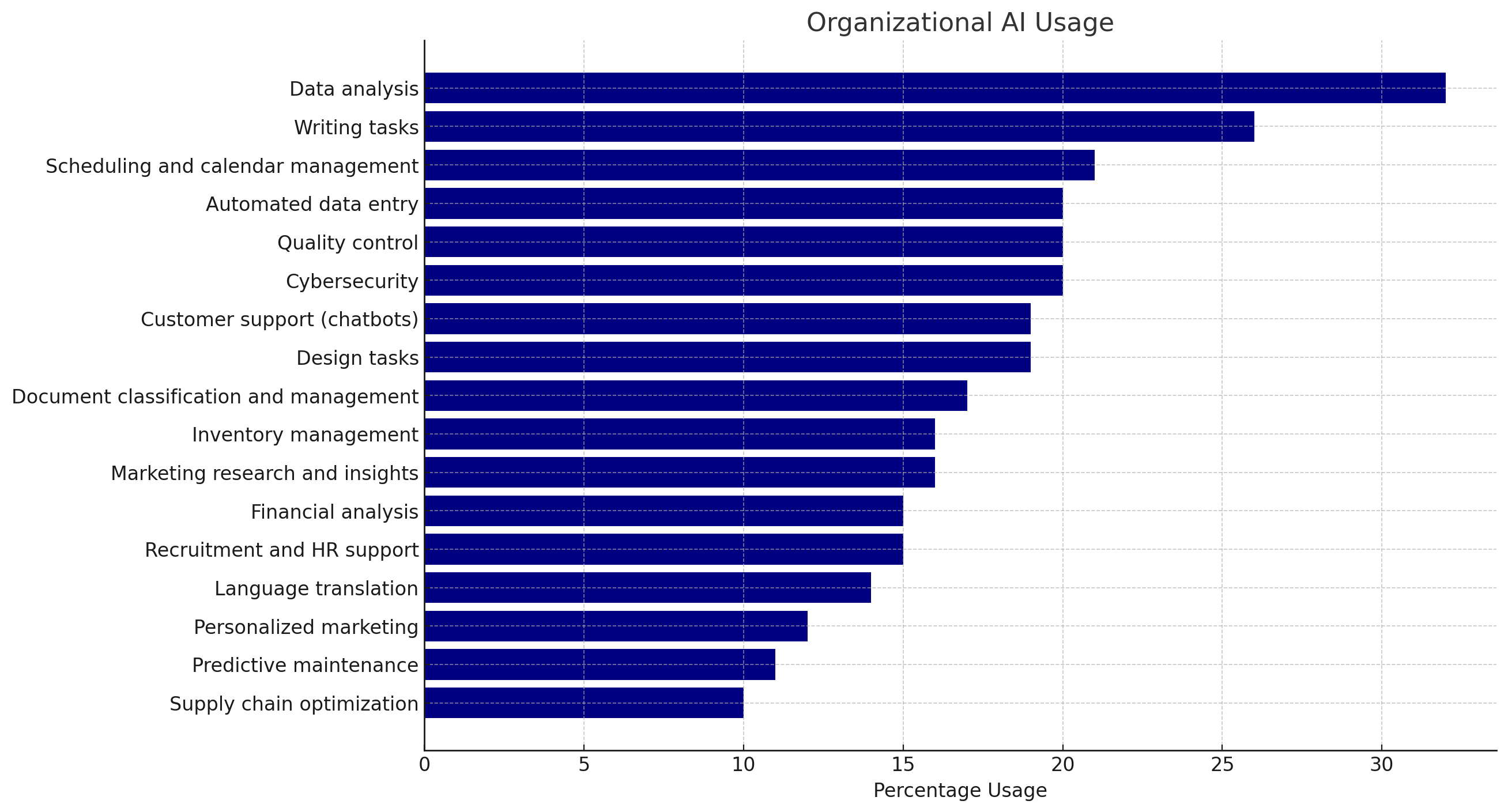-
Contents
- The State of Enterprise Adoption
- Embracing the AI Revolution
- Demystifying AI
- A Comprehensive Roadmap for AI Integration
- Concluding Thoughts

The State of Enterprise Adoption
The Cautious Embrace
In today’s fast-changing digital world, artificial intelligence (AI) is a game-changer, catching the attention of business leaders everywhere. However, despite the excitement, there’s a sense of caution in the corporate world. According to tech.co‘s “Impact of Technology on the Workplace” report, over two-thirds (67%) of business leaders say that AI integration in their companies is either limited or non-existent. This careful approach is due to several reasons, such as cybersecurity worries, industry-specific issues, and unclear business cases for AI adoption. Balancing innovation with risk management has become a tricky task for decision-makers in various fields.
The Paramount Priority of Cybersecurity
As companies deal with the challenges of AI implementation, one thing stands out: the importance of cybersecurity. A significant 40% of respondents mentioned cybersecurity threats as a major factor that will affect their performance in 2024. This awareness has led organizations to look into AI-powered tools to strengthen their cybersecurity efforts, with nearly one-fifth (19%) already using such solutions. In a time when data breaches and cyber attacks can seriously harm businesses, protecting digital assets has become a key driver behind AI adoption strategies. Companies are looking for new ways to use AI to boost their defenses, spot anomalies, and stay ahead of constantly changing cyber threats.

Key Use Cases of AI Across Organizations
While the level of AI integration varies by industry, some use cases have become leaders in showing the technology’s potential. Data analysis is the top application, with just under a third (32%) of companies using AI for this important task. The ability to handle large amounts of data and find valuable insights is crucial in today’s data-driven business world. Writing tasks, from emails to reports, have also seen a rise in AI adoption, with 26% of companies using these solutions. The promise of better efficiency and productivity has led organizations to explore AI-powered writing tools, making communication and documentation easier. Besides these main uses, AI is also being used in other areas like scheduling and calendar management (21%), automated data entry (20%), and customer service and support (19%). As businesses aim to improve their operations and customer experiences, AI’s versatility has opened up many possibilities.
AI’s Impact on Workplace Productivity
Although AI adoption may be slow, its effect on workplace dynamics is clear. Interestingly, the research found a positive link between AI integration and fewer weekly work hours. Among the small 4% of organizations that have fully embraced AI, a huge 93% are open to a four-day workweek. This exciting possibility has big implications for finance teams struggling with talent shortages and organizations dealing with employee burnout.and retention challenges. By using AI to simplify tasks and boost efficiency, companies can find a balance between productivity and work-life balance, leading to a more engaged and happy workforce. However, this ideal scenario has its hurdles. In companies without AI integration, opinions on flexible work policies were divided, with 41% in favor and 38% against. Overcoming these fixed views and showing the real benefits of AI-enabled productivity will be key to gaining widespread acceptance.
Embracing the AI Revolution
As the AI revolution progresses, businesses face a critical choice. They can either embrace this powerful technology, tackling the challenges and seizing the opportunities it offers, or risk falling behind in a fast-changing and competitive world. To succeed in this new era, companies must foster a culture of innovation, encourage teamwork across departments, and focus on continuous learning and skill development. By investing in AI education, addressing ethical issues, and customizing solutions to meet specific industry needs, businesses can set the stage for sustainable growth and long-term success. The journey ahead may be tough, but the potential rewards are huge. By using AI responsibly and ethically, companies can unlock new levels of productivity, efficiency, and innovation, while also creating a more engaged, empowered, and satisfied workforce. The future belongs to those who embrace change, adapt quickly, and harness the transformative power of emerging technologies like AI. The time to act is now, as those who delay risk being left behind in this major technological shift.

Demystifying AI
Before starting your AI integration journey, it’s important to understand the basic concepts and technologies that make up this revolutionary field. AI includes a wide range of disciplines, each with its own unique capabilities and applications.
Machine Learning (ML)
At the core of AI is Machine Learning, a powerful method that allows computers to learn from data without being explicitly programmed. ML algorithms analyze patterns, identify trends, and make predictions based on the data they receive, continually improving their accuracy through repeated training. This branch of AI drives many advanced applications, including recommendation engines, fraud detection systems, and predictive analytics.
Natural Language Processing (NLP)
Have you ever been amazed by how virtual assistants like Siri or Alexa can understand and respond to spoken commands? This is made possible by Natural Language Processing, a field focused on enabling computers to understand, interpret, and generate human language. NLP powers chatbots, language translation tools, and sentiment analysis systems, among other applications.
Computer Vision
Imagine a world where machines can see and analyze visual data as well as humans. Computer Vision makes this possible by giving computers the ability to identify and interpret objects, faces, and scenes from images and videos. This technology has transformed industries such as healthcare, retail, and transportation, enabling applications like facial recognition, self-driving vehicles, and medical imaging.
By understanding these key areas of AI, businesses can better navigate the challenges of AI adoption and leverage its potential to drive innovation and growth. The path to successful AI integration may be complex, but with the right knowledge and approach, companies can overcome the challenges and reap the benefits of this transformative technology.### Artificial Neural Networks and Deep Learning
Artificial Neural Networks are models inspired by the brain’s neural structure. These networks learn from large datasets, recognizing patterns and making accurate predictions. Deep Learning, a part of Machine Learning, uses these networks to handle complex tasks like image and speech recognition, natural language processing, and even playing strategic games at superhuman levels. With this basic understanding, you can grasp AI’s diverse capabilities and find the best technologies to solve your business’s unique problems.
A Comprehensive Roadmap for AI Integration
Assessing Readiness for AI Adoption
Defining Business Objectives and Use Cases
Begin by clearly defining your business goals and identifying specific AI use cases that add value, such as improving customer experiences or streamlining operations.
Evaluating Existing Infrastructure and Data
Check your data infrastructure and current technology to ensure they support AI implementation. Identify any gaps or limitations that need fixing.
Assessing Internal Expertise and Resource Availability
Evaluate your organization’s internal AI skills. If there are gaps, consider hiring, training, or partnering with external AI service providers.
Identifying Potential Risks and Challenges
Address risks like data privacy, algorithmic bias, and regulatory compliance by conducting a thorough risk assessment and developing mitigation strategies.
Crafting Your AI Strategy
Defining SMART Goals
Set Specific, Measurable, Achievable, Relevant, and Time-bound (SMART) goals directly tied to your business objectives and AI use cases.
Selecting the Right AI Technologies and Platforms
Choose AI technologies that align with your goals, budget, and existing infrastructure by conducting thorough research and evaluations.
Developing a Phased Implementation Plan
Break down your implementation into manageable phases, starting with a pilot project to test and refine your approach.
Allocating Resources and Budgeting
Develop a comprehensive budget and allocate resources strategically, prioritizing high ROI initiatives.
Establishing Governance and Compliance Frameworks
Create governance and compliance frameworks to address data privacy, security, algorithmic fairness, and regulatory compliance.

Validating Your AI Vision
Identifying a Suitable Use Case
Select a specific, measurable use case aligned with your AI strategy to test your AI solutions.
Developing a Prototype or Minimum Viable Product (MVP)
Create a functional prototype to demonstrate core features and engage cross-functional teams in its development.
Establishing Performance Metrics and Success Criteria
Set clear performance metrics to objectively evaluate your AI solution’s effectiveness.
Analyzing Results and Making Informed Decisions
Analyze feedback against success criteria to decide on full-scale implementation or necessary adjustments.
AI Integration Planning
Designing the Integration Architecture
Collaborate with IT and AI experts to design a robust architecture addressing data flow, API integrations, scalability, and security.
Identifying Potential Bottlenecks and Constraints
Assess and mitigate potential infrastructure bottlenecks through upgrades or cloud resources.
Planning for Data Integration and Management
Develop a comprehensive data strategy for data acquisition, preprocessing, storage, and governance.
Developing a Comprehensive Testing and Validation Plan
Create a detailed testing plan including unit, integration, performance, and user acceptance testing.
Planning for Continuous Improvement
Establish a feedback loop to continuously monitor and improve AI systems, ensuring they adapt to changing business needs and technological advancements.
By following this roadmap, businesses can navigate the challenges of AI adoption and leverage its potential to drive innovation and growth. The path to successful AI integration may be complex, but with the right knowledge and approach, companies can overcome the challenges and reap the benefits of this transformative technology.### Deployment and Rollout
Creating a Deployment Plan
Develop a deployment plan that includes phased rollouts, user training, and change management strategies.
API Integration and Customization: Tailoring AI to Your Needs
Setting Up API Integrations
Configure APIs to ensure smooth interaction with your software, focusing on authentication, data formats, and secure communication.
Customizing AI Models and Algorithms
Collaborate with data scientists to fine-tune AI models for your specific needs by retraining models and adjusting parameters.
Integrating Existing Data Sources
Ensure AI solutions access high-quality, up-to-date data through robust data pipelines and workflows.
Ensuring Compatibility and Scalability
Plan for future scalability and address compatibility with existing technology through modular design and containerization.
Continuous Testing and Validation
Establish continuous testing frameworks to ensure ongoing performance and accuracy of AI solutions.
Ensuring Reliable AI Performance Through Testing and Validation
Developing a Comprehensive Testing Strategy
Create a strategy that includes unit, integration, performance, security, and user acceptance testing. This holistic approach helps identify potential issues early and minimizes risks.
Unit Testing for AI Components
Develop robust unit tests to validate the functionality and accuracy of individual AI models and algorithms. Use automated testing tools and regularly update tests as models evolve.
Integration Testing
Ensure different AI system components work together seamlessly by testing interactions between models, APIs, data pipelines, and existing software systems. This helps identify and resolve data integration and compatibility issues.
Performance Testing
Evaluate the AI system’s responsiveness, stability, and scalability under various conditions. Simulate real-world workloads to measure response times, throughput, and resource utilization, and optimize performance.
Security Testing
Assess the AI system’s resilience against potential threats and vulnerabilities. Implement security best practices and ensure compliance with relevant regulations to safeguard your AI solutions.
User Acceptance Testing (UAT)
Engage end-users and stakeholders to validate functionality and performance. Gather feedback on usability and overall experience, addressing issues before final deployment.
Continuous Testing and Validation
Maintain ongoing performance and accuracy through continuous testing frameworks. Regularly update and refine tests to ensure reliability and effectiveness over time.
By meticulously planning and executing a comprehensive testing strategy, you ensure your AI solutions are reliable, accurate, and performant, meeting the highest quality standards.
Concluding Thoughts
In the evolving digital landscape, AI stands as a transformative force with immense potential. Yet, many businesses approach AI adoption with caution due to cybersecurity concerns, industry-specific challenges, and unclear business cases. Despite this, the growing emphasis on cybersecurity and the demonstrated benefits in key areas such as data analysis and customer service highlight AI’s vital role in modern enterprises.
Successful AI adoption demands thorough readiness assessments, a strategic implementation plan, and meticulous testing and validation. Working with specialized AI partners like Processica can significantly enhance this process. Our experts provide the necessary skills for AI implementation, customization, and testing, ensuring that AI solutions are tailored to meet specific business needs and overcome unique challenges.
By partnering with Processica, enterprises can navigate the complexities of AI integration more effectively, achieving a seamless transition and unlocking new levels of productivity and innovation.


